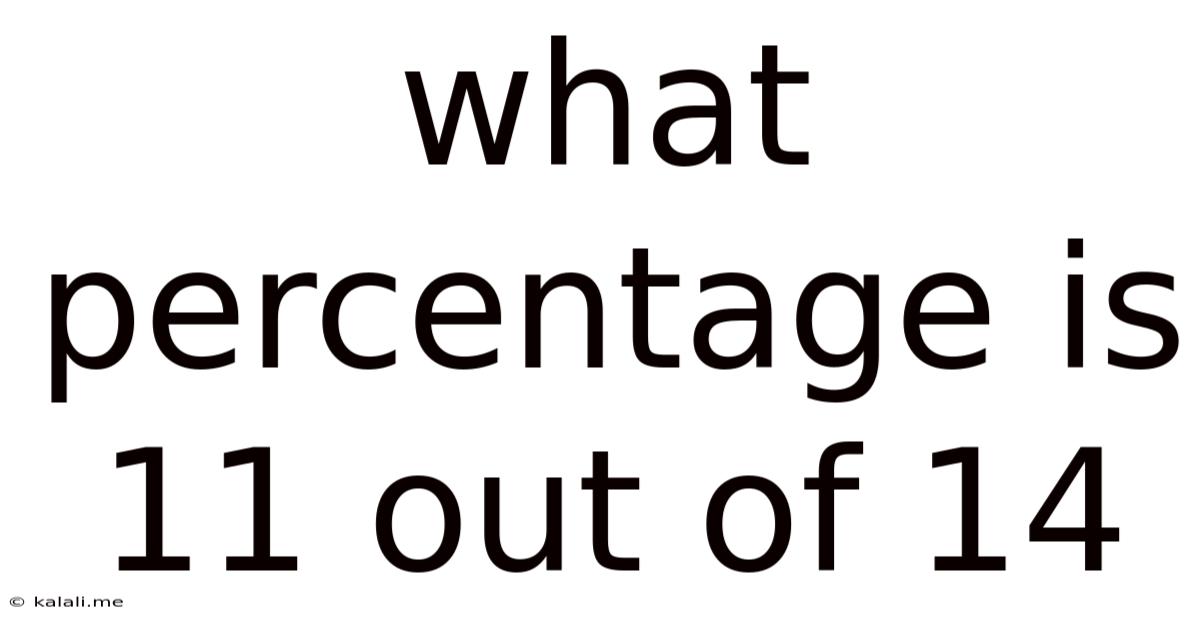What Percentage Is 11 Out Of 14
Kalali
Jul 29, 2025 · 4 min read

Table of Contents
What Percentage is 11 out of 14? A Comprehensive Guide to Percentage Calculations
Understanding percentages is a fundamental skill in many areas of life, from calculating discounts in a store to analyzing financial reports. This article will delve deep into calculating the percentage that 11 represents out of 14, providing not only the answer but also a thorough explanation of the process and exploring various related concepts. This will equip you with the knowledge to confidently tackle similar percentage problems in the future.
Understanding Percentages: The Basics
A percentage is a way of expressing a number as a fraction of 100. The symbol "%" represents "per cent," meaning "out of one hundred." For example, 50% means 50 out of 100, which is equivalent to the fraction 50/100 or the decimal 0.5.
Calculating percentages involves expressing a given ratio as a fraction of 100. This can be done using a simple formula:
(Part / Whole) * 100 = Percentage
In our case, the "part" is 11, and the "whole" is 14. Therefore, the formula becomes:
(11 / 14) * 100 = Percentage
Calculating the Percentage: Step-by-Step
Let's break down the calculation step-by-step:
-
Divide the part by the whole: 11 divided by 14 is approximately 0.7857.
-
Multiply the result by 100: 0.7857 multiplied by 100 is 78.57.
-
Add the percentage symbol: The final answer is 78.57%.
Therefore, 11 out of 14 is approximately 78.57%.
Rounding and Precision
Depending on the context, you might need to round the percentage to a specific number of decimal places. For instance, you might round 78.57% to 78.6% for simpler communication or to 79% for a rough estimate. The level of precision needed will depend on the application. In many cases, rounding to one decimal place (78.6%) provides a good balance between accuracy and simplicity.
Alternative Methods for Calculating Percentages
While the formula (Part / Whole) * 100 is the most straightforward method, there are alternative approaches you can use:
-
Using Proportions: You can set up a proportion to solve for the percentage. The proportion would look like this:
x/100 = 11/14
To solve for x (the percentage), you would cross-multiply:
14x = 1100
x = 1100/14 ≈ 78.57
-
Using a Calculator: Most calculators have a percentage function that simplifies the calculation. Simply enter 11 ÷ 14 × 100 to obtain the result.
-
Using Spreadsheet Software: Spreadsheet software like Microsoft Excel or Google Sheets provides built-in functions for percentage calculations. The formula
=(11/14)*100will give you the same result.
Practical Applications of Percentage Calculations
Understanding how to calculate percentages is crucial in various real-world scenarios:
-
Finance: Calculating interest rates, discounts, profits, losses, tax rates, and investment returns.
-
Retail: Determining sale prices, markups, and discounts.
-
Science: Expressing experimental results, analyzing data, and representing proportions.
-
Education: Calculating grades, test scores, and class averages.
-
Everyday Life: Determining tips, splitting bills, and understanding statistics.
Expanding on the Concept: Related Percentage Problems
Let's explore some related percentage problems that build upon the understanding we've gained:
-
Finding the Part: If you know the percentage and the whole, you can find the part using the formula:
(Percentage/100) * Whole = Part
For example, what is 25% of 60? (25/100) * 60 = 15
-
Finding the Whole: If you know the percentage and the part, you can find the whole using the formula:
Part / (Percentage/100) = Whole
For example, if 10 is 20% of a number, what is that number? 10 / (20/100) = 50
-
Percentage Increase/Decrease: Calculating percentage changes involves finding the difference between two numbers and expressing it as a percentage of the original number. The formula is:
((New Value - Old Value) / Old Value) * 100 = Percentage Change
Advanced Percentage Concepts: Compounding and Weighted Averages
More complex scenarios might involve compounding percentages (calculating percentages on percentages) or weighted averages (calculating percentages where different values have different weights).
Compounding Percentages: Imagine you invest $100 and earn 10% interest the first year, resulting in $110. If you earn another 10% interest in the second year, it's calculated on $110, not the original $100. This is compounding.
Weighted Averages: Consider calculating the average grade in a class where assignments have different weights. A major exam might count for 50%, while smaller assignments count for the remaining 50%, distributed among several assessments. The weighted average accounts for these different weights to arrive at a final grade.
Conclusion: Mastering Percentage Calculations
Understanding how to calculate percentages is a valuable skill applicable in numerous contexts. We've explored the process of calculating the percentage that 11 represents out of 14, explained the underlying principles, and expanded on related percentage problems. By mastering these techniques, you'll be well-equipped to tackle a wide array of percentage-related calculations confidently and accurately, enhancing your problem-solving skills in various aspects of life. Remember that practice is key, so try working through different examples and applying these concepts in real-world situations to solidify your understanding.
Latest Posts
Latest Posts
-
Is Avril Lavigne Related To Adam Levine
Jul 29, 2025
-
A Penny Doubled Everyday For 365 Days Formula
Jul 29, 2025
-
4 Letter Words With 3rd Letter A
Jul 29, 2025
-
How Long Is A Track Around A Football Field
Jul 29, 2025
-
How Many Oz In A Pint Of Sour Cream
Jul 29, 2025
Related Post
Thank you for visiting our website which covers about What Percentage Is 11 Out Of 14 . We hope the information provided has been useful to you. Feel free to contact us if you have any questions or need further assistance. See you next time and don't miss to bookmark.